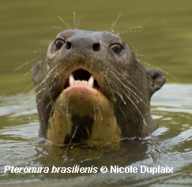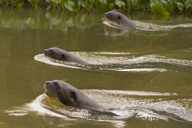 |
Last Update:
Sunday February 22, 2015 |
| •[Home] | [Site Map] | [Contact Us]• | |
| [Home] | [Members] | [News] | [Bulletin] | [Q & A] | [Species] | [Library] |
Pteronura brasiliensis (Gmelin, 1788), the Giant Otter (currently being revised)
|
|
DescriptionIn body length, Pteronura brasiliensis, is the largest of the world’s 13 otter species, (the sea otter, with its more compact body, may weigh considerably more). Giant otter males attain an overall length of 1.5 to 1.8m and a weight of between 26 and 32 kg; females generally measure 1.5 to 1.7 m in length and may weigh between 22 and 26 kg (Duplaix 1980). It is difficult to distinguish between the male and female giant otter because there is no fundamental difference in head or body size. Coat colour ranges from fawn to reddish-brown to very dark burnt umber, the dense, velvet-like fur being composed mainly of short, waterproof guard hairs with very little underfur. The throat and chest are usually marked with irregular cream-coloured patches or spots (which may be virtually absent or form a large white area); the muzzle, lips and chin are often spotted white (Duplaix, 1980). The short, squat limbs end in large, fleshy feet with very well developed webbing, extending to the tips of the clawed digits. The tail is dorsoventrally flattened like that of a beaver, and thickly muscular at the base. The head is broad and bullet shaped, with a blunt, sloping muzzle, and is supported by a long muscular neck (Duplaix 1980). Long and numerous facial whiskers protrude from the muzzle, forehead and temples and are believed to be highly sensitive in order to facilitate prey location in turbid waters, when vision is impaired (Duplaix 1980). The otter’s nostrils (placed forward on top of the head) and its small, round ear pinnae (set high and well back), may both be closed to prevent entry of water while diving.” (Taken from Groenendijk 1998) HabitatThe giant otter frequents rivers, streams, lakes, and swamps of tropical lowland rainforests. This species is particularly vulnerable to human disturbance.Giant Otters live in slow-moving freshwater rivers, lakes and streams with gently sloping banks and overhanging vegetation. Duplaix (1980) found that they did not favour either mangrove swamps or coastal areas in Suriname. They prefer areas with abundant prey in relatively shallow water, with easy access to forest creeks or swamps. Clear water makes hunting easier, so if available, they choose dark waters, where the water is clear, but stained dark with decomposition products of forest vegetation, even though these environments support less prey than whitewater areas as the humic acid does not favour the microorganisms that prey species feed on. In Peru, where whitewater, i.e. water with a high sediment load, is more common, the otters choose oxbow lakes, where the sediment tends to settle to the bottom. They are also found in swamps and marshes, and have occasionally been recorded in reservoirs and agricultural canals. DistributionHistorically giant otters ranged throughout the tropical lowland rainforests and wetlands of South America. Currently remnant populations exist in Bolivia, Brazil, Colombia, Ecuador, French Guiana, Guyana, Paraguay, Peru, Suriname, and Venezuela, but the giant otter is considered extinct in Argentina and Uruguay. Precise distribution data is still being accumulated but at this time it is believed that some individuals may remain in Paraguay, the giant otters are very rare in Ecuador and large parts of Brazil, and are rare in Bolivia, Colombia, Venezuela, Peru, and in the western parts of the Brazilian Amazon. The last major giant otter strongholds are believed to probably be in Guyana, Suriname, and French Guiana although there is almost no data for the latter country. It also should be noted that Schweizer (1992; in Carter & Rosas 1997) reported that around 500 giant otters inhabit the southern area of the upper Paraguai River basin of Brazil known as the Pantanal. Conservation StatusRed List Category Endangered, Decreasing Accelerating habitat destruction is likely to reduce the population by 50% over the next 20 years (three Giant Otter generations). CITES Status: Appendix I Wild population: estimated total population of 1,000 to 5,000 individuals In the past giant otters were frequently hunted for their fur. This trade in giant otter pelts is one of the primary reasons giant otters are endangered in the wild. Because this species is active during the day, very vocal, and not afraid to approach humans they were easy to hunt. Much of the population became decimated until efforts were finally made to protect them in the 1970’s. Current ConcernsAlthough they still face other serious threats – habitat destruction and degradation, poaching, and unmanaged tourism are the primary threats faced by giant otter today. The areas in South America where the giant otter lives are rapidly being destroyed and degraded by logging, mining, exploitation of fossil fuels and hydroelectirc power (dams), river and land pollution, and over-fishing. Some giant otter cubs are still being taken from the wild illegally to be kept as pets and they usually die in the hands of inexperienced caretakers. Tourists can disturb giant otters when they are rearing cubs. This can have a negative affect on how successfully parents rear their litters. Current Research and Conservation Priorities (OSG Frostburg, MD 2004)The following priorities were established for the giant otter during the last meeting of the IUCN/SSC Otter Specialist Group:
Leading ResearchersNicole Duplaix, Fernando Rosas, Miriam Marmontel, Paul van Damme, Jessica Groenendijk and Frank Hajek Key PublicationsGeneral
Useful Links
Revised 18th December 2007 Nicole Duplaix |
| [Copyright � 2006 - 2011 IUCN OSG] | [Home] | [Site Map] | [Contact Us] |







